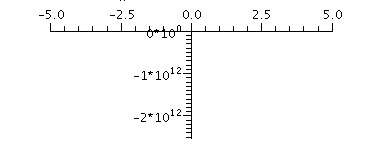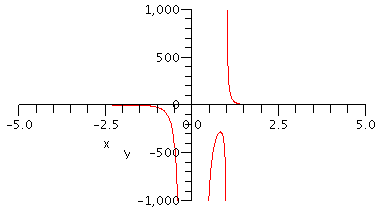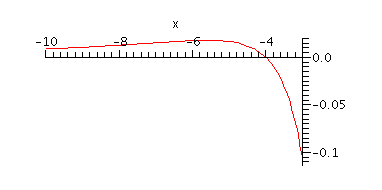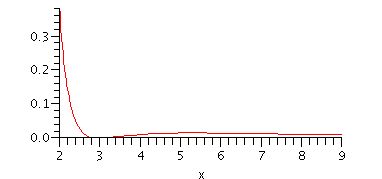
| > |
MATH 131, section 1 -- Calculus for Physical and Life Sciences 1
"Advanced Graphing" with Calculus and Calculators/Maple
November 12, 2007.
First, let's take a fairly complicated rational function like

Let's see what happens if we plot this "blindly":
| > |  |

| > |

Pretty uninformative, right! What is going on here? It should be
somewhat clear from the formula that the graph has vertical asymptotes
that are producing the huge range of y - values shown in this plot.
We can also analyze the function to see which direction the graph
should be approaching the asymptotes. The results of this are that
the graph should be going down to ![]() on both sides of 0. It should
on both sides of 0. It should
be tending to ![]() as
as ![]() and it should be tending to
and it should be tending to ![]() as
as
![]()
Moreover,
![]()
so the x-axis is a horizontal asymptote.
We should begin by cutting down the y-range (and also tell Maple to
expect discontinuities) to get something more reasonable:
| > |

This is a lot closer to an accurate plot of the function.
Note in particular that it seems that there is a local
maximum on the part of the graph on the interval
(0,1) which matches what we said above about the
direction of approach to the asymptotes!
But we are still missing some important features of this
function(!) Note that
![]()
from the factorization of the numerator. So in fact the graph should
intersect the x-axis at x = -4 and again at x = 3. This is
not clear at all from the plot above. And there's no way we're ever
going to see those intersections with a range of y-values that
is this big (-1000 ≤ y ≤ 1000).
So in fact to see what is going on, we should probably not look just at
one graph, but rather look at separate plots for x around
-4 and for x around 3. Here's a plot for -10 ≤ x ≤ -3
which shows that the graph crosses from positive to negative
y-values at ![]()
| > |
| > |

Note that this forces a local maximum of f somewhere to the left of ![]()
apparently around ![]() so, since f is tending to 0 as
so, since f is tending to 0 as
![]()
Let's also plot f on a range of values starting to the left of 3
and going past 3 to the right.
| > |

Notice that the graph appears to be tangent to the x-axis at
![]() Since f tends to 0 as
Since f tends to 0 as ![]() this means that there
this means that there
must be another local maximum somewhere to the right of
![]() This is apparently at about
This is apparently at about ![]() although it is difficult
although it is difficult
to tell since the graph seems very flat between 5 and 6).
So at this point we can see from the plots:
▽ f has vertical asymptotes at ![]()
▽ f has a horizontal asymptote at ![]()
▽ f has at least 4 critical numbers (where ![]()
Are we missing any other important features (e.g. other
critical numbers, etc.?
Sophisticated programs like Maple can be used to
compute derivatives as well as generate graphs. Here's
the derivative of our function, simplified:
| > |

The critical numbers are the roots of the numerator. Maple
also has numerical routines for finding approximate solutions
of equations:
| > |
![]()
Since there are only 4 roots (including all the critical numbers found
above), this is apparently a complete picture now!
| > |